Understanding the Dynamics of Strike Ride in Kiteboarding
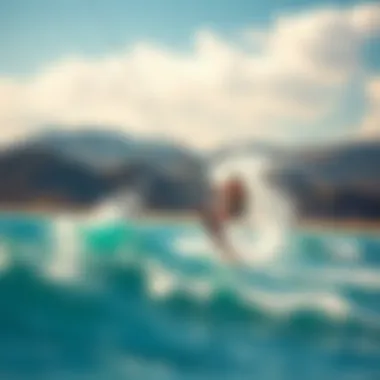

Intro
Kiteboarding is more than just a sport; it’s an interplay of artistry, adrenaline, and physics. Among the various riding styles, the concept of strike ride stands out as a particularly exhilarating method to carve through the water with control and finesse. While many kiteboarders are familiar with the fundamentals, understanding the nuances of strike riding can elevate anyone’s performance. Whether you’re just getting started or have years under your belt, let's dive into the elements that define this distinct approach and why it might just become your favorite way to kite.
Gear and Equipment
Understanding the right gear is crucial when it comes to strike riding. While there are many options out there, selecting the right equipment will make all the difference. Let’s break it down:
Essential Kiteboarding Gear for Beginners
For novices, simplicity is key. Here’s a rundown of the must-have items:
- Kite: Look for a beginner-friendly kite. Brands like Cabrinha and Naish manufacture kites that emphasize stability and easy launching.
- Board: A wider board offers more surface area, making it easier to ride and balance.
- Harness: A comfortable harness is essential for effective power transfer.
- Safety Equipment: A leash is non-negotiable. It helps to keep the kite under control while learning new tricks.
Choosing the right gear ensures that you will have a smooth trajectory as you explore the world of strike riding. Ensuring your kite and board align with your style will have a marked impact on performance.
Advanced Equipment for Experienced Riders
As you gain more experience, investing in advanced gear can further enhance your strike ride abilities. Consider:
- High-Aspect Kites: These kites provide better upwind performance.
- Twin-Tip Boards: They facilitate switch riding and offer versatility.
- Footstraps: These enable greater control and comfort when engaging in freestyle moves.
- Impact Vest: Essential for safety while experimenting with high-risk maneuvers.
Whether you are just starting or have hit a plateau, revisiting your equipment can reinvigorate your energy on the water.
Techniques and Tips
Understanding strike ride is about honing your technique and ensuring safety throughout your rides. Here are a few strategies to navigate the waters smoothly:
Safety Practices for Kiteboarding
Safety should always be at the forefront of your mind. Consider these vital practices:
- Pre-Ride Checks: Analyze your gear before launching. Inspect lines and connections carefully.
- Recognizing Conditions: Learn to read wind patterns and water conditions to prevent accidents.
- Kite Control: Practice flying your kite in a controlled environment before heading out to more challenging locations.
"Preparation is the key to success in kiteboarding."
Training Techniques to Improve Your Skills
Enhancing your strike riding skills involves practice and persistence. Here’s how:
- Focus on Timing: Pay attention to how your body moves with the kite and water. Develop a sense of timing that allows for smoother maneuvers.
- Ride Regularly: The more time you spend on the water, the more confidence you will gain.
- Seek Feedback: Join local kiteboarding groups on platforms like Reddit or Facebook, where you can learn from fellow riders and share experiences.
End
Mastering the dynamics of strike ride doesn’t happen overnight. It requires patience, practice, and the right mindset. Yet, the thrill gained from tracing the water’s surface with precision makes every effort worth it. Remember, the journey is just as important as the destination, and each ride offers lessons that can’t be found in books alone. For further reading on kiteboarding and related equipment, check resources like Wikipedia, Britannica, and forums on Reddit.
Understanding Strike Ride in Kiteboarding
Understanding the concept of strike ride in kiteboarding is not just a technical necessity; it’s a cultural cornerstone for enthusiasts of the sport. At its core, strike ride embodies a unique style that transcends mere mechanics and touches on the artistry of kiteboarding. It emphasizes how a rider interacts with the wind and water, focusing not only on skill but also on individual expression.
Definition and Overview
Strike ride can be thought of as an interplay between the kite, the rider, and the conditions. It's about harnessing the wind's power strategically while maintaining control over the board. Picture this: you’re zipping across the surface, carving through waves, with the kite soaring above, working in perfect harmony. The essence of strike ride hinges on understanding how to leverage power to boost performance while also riding with grace and finesse.
There are technical components that define this riding style. Proper kite positioning, careful control over the line tension, and a solid stance on the board are all critical. The rider needs to develop a sense of timing and rhythm to make the most of this technique. It’s not merely a matter of skill; it requires an almost intuitive grasp of environmental factors such as wind speed, water conditions, and personal ability.
Importance in Kiteboarding Culture
The importance of strike ride in kiteboarding cannot be overstated. It represents not only a set of skills but also a way of life for many enthusiasts within the community. When riders talk about "going out for a strike ride," they are echoing a tradition that emphasizes freedom, self-expression, and the thrill of mastering nature. This practice encourages riders to connect with each other through shared experiences and skills, fostering a sense of camaraderie.
Engaging in strike ride also carries a sense of respect for the environment and fellow riders. Understanding the elements at play—like wind shifts and water currents—is crucial not just for individual performance but also for ensuring safety and enjoying the ride. As a result, strike ride serves as an excellent example of how sport, culture, and environmental awareness intertwine.
In summary, grasping the nuances of strike ride enriches one's kiteboarding experience, offering a deeper connection to the sport and its community. For both newcomers and seasoned riders, this understanding lays the groundwork for developing advanced techniques, enhancing individual style, and adhering to the values of safety and respect that the kiteboarding culture cherishes.
"Mastering the dynamics of strike ride transforms not only your skill set but how you relate to the kiteboarding community at large. It’s about riding the winds of shared passion and knowledge."
Useful Resources
For further exploration, consider checking out these resources:
As you delving deep into understanding strike riding, you’ll discover not just better techniques but a more profound appreciation for the art and culture surrounding kiteboarding.
Technical Aspects of Strike Ride
Understanding the technical aspects of strike ride is akin to understanding the very heart of kiteboarding itself. This riding technique involves various components that influence performance, safety, and overall enjoyment during the ride. Crucial elements include kite control, board positioning, and body mechanics. Mastering these aspects is not just about improving skills; it’s about enhancing the entire kiteboarding experience. Riders can harness wind dynamics, manage their body posture, and learn to engage in techniques that elevate their ride from mediocre to extraordinary.
Kite Control Techniques
Understanding Wind Dynamics
At the core of kiteboarding lies a deep relationship with wind dynamics. Understanding this not only shapes how a rider navigates the water but also enhances their ability to respond to changing conditions. Wind is unpredictable, swinging between gentle breezes to fierce gales. Deciphering these quirks helps in making informed decisions while on the water.


A key characteristic of grasping wind dynamics is the ability to recognize wind patterns and gusts. This knowledge allows riders to anticipate shifts which, in turn, aids in effective maneuvering. By being able to feel the wind and recognize its strengths, kiteboarders can adjust their riding style accordingly—a beneficial skill that adds to both safety and performance. The biggest advantage here is the rider's capacity to exploit even the slightest breeze, turning what could be a struggle into a seamless glide.
Adjusting Power and Lift
The next element to tackle is adjusting power and lift. This aspect is essential in ensuring a smooth flight across the water. Kiteboarders learn to modulate the kite’s position to either increase power for speed or decrease it to regain control. Understanding how to manipulate the kite effectively can significantly affect the ride.
A pivotal characteristic of adjusting power and lift is the dynamic relationship between kite angle and rider weight. When proper adjustments are made, the rider can experience increased height and distance on jumps, thus making this technique popular among both newcomers and seasoned veterans. Riders must be cautious, though, as improper control may lead to erratic movements or loss of balance.
Board Positioning
Foot Placement Strategies
Foot placement strategies play a vital role in the overall success of a strike ride. The position of the feet on the board determines balance and control. Proper foot placement can mean the difference between a smooth ride and a jarring wobble. A good positioning strategy involves aligning feet based on the wind direction and body weight.
The beauty of well-executed foot placement lies in its simplicity; riders can adjust based on comfort and style, making it a popular choice among all levels of kiteboarders. However, it’s essential to remember that experimenting with foot placement also comes with challenges. A change in foot location can alter dynamics considerably, requiring constant adjustments and practice.
Balancing Techniques
Once foot placement is well understood, the next step is mastering balancing techniques. Balancing properly on a kiteboard is of utmost significance to maintain control, especially at higher speeds. The key to effective balancing includes aligning the body’s center of gravity over the board while keeping knees slightly bent.
This balancing technique is beneficial because it allows for the rider to adapt to changing water surfaces, wind conditions, and even sudden movements. However, achieving the right balance may prove tricky, especially for beginners; it requires not just strength but also a keen sense of awareness about one’s body. The unique feature of balancing is that it involves adjustments made in real-time, training riders to develop reaction skills and body awareness.
Body Mechanics
Engaging Core Muscles
At the heart of effective kiteboarding is engaging core muscles during a strike ride. A strong core not only supports stability but also provides the necessary control for executing turns and jumps. Core engagement allows for centralizing forces while on the board, resulting in better maneuverability.
The key characteristic here is that engaging the core helps in maintaining proper posture and reducing fatigue over time. This technique fosters longer rides with less physical strain, making it an attractive choice for both amateur and professional kiteboarders looking to improve their performance. It's worth noting, however, that core training requires commitment; neglecting this might lead to poorer overall performance.
Maintaining Stance
Lastly, maintaining a stable stance is critical for anyone looking to master strike ride. A strong stance involves shifting one’s weight forward or backward based on the forces experienced from the kite and water. Finding that sweet spot where the body remains balanced enhances control and ensures better responsiveness to directional changes.
This aspect is beneficial since it contributes directly to the overall handling of the kiteboard, allowing for smooth transitions between movements. However, the challenge lies in maintaining this stance consistently over various conditions, requiring attention and practice. A slightly off-kilter stance can lead to falls or reduced performance, highlighting the necessity of honing this skill over time.
In essence, understanding the technical aspects of strike ride is not just about practical skills; it’s about creating a deeper connection with the sport, resulting in a rewarding and dynamic experience.
Safety Considerations
Safety in kiteboarding is like the backbone of the entire experience—without it, even the best ride can take a nasty turn. The thrill of strike riding can be electrifying, but with that excitement comes the need for prudence. Understanding and implementing safety considerations can save lives and ensure enjoyable sessions.
Identifying Hazards
Understanding Water Conditions
In kiteboarding, the water is your dance floor. However, not every surface is ideal for a thrilling ride. Understanding water conditions, such as tides, currents, and wave heights, can significantly impact your performance and safety. For instance, shallow waters can reveal unexpected hazards like rocks or sandbars, posing risks to riders unaware of their surroundings.
Key characteristics include recognizing the shift in tides and how they dictate water levels. Knowledge in this realm allows riders to choose times when conditions are favorable. Factors like strong currents can turn a blissful session into a struggle. On the flip side, calm waters are generally a beneficial setting for beginners while also offering a smoother strike ride experience for experts looking to execute complex maneuvers with style.
However, too much calm can indicate a lack of wind, thus affecting the kite’s performance. Keeping an eye on the water conditions is a must—it’s all part of the kiteboarding playbook.
Watching for Other Riders
It's a crowded field out there, especially when the wind is at the right speed. Watching for other riders is essential for preventing collisions and keeping the vibe in check. Kiteboarding spots often attract many enthusiasts, leading to potential accidents if riders aren’t alert.
The key characteristic here is awareness. By maintaining a good lookout for fellow kiteboarders, one can execute maneuvers without the worry of crashing into someone else. This practice benefits not only the individual rider but also contributes to a safer overall kiteboarding community.
Of course, there’s a sensitive balance involved. While keeping an eye out is crucial, over-focusing on other riders can lead one to neglect their own riding technique. Keeping that active watch while still focusing on your riding skills is a skill worth developing.
Safety Gear Recommendations
Essential Equipment
When it comes to safety in kiteboarding, the right gear can make all the difference. Essential equipment includes harnesses, helmets, and buoyancy aids. Each piece of equipment plays a pivotal role in protecting the rider from unforeseen incidents, such as falls or unforeseen winds that could cause loss of control.
One important aspect to highlight about safety gear is its customization. Different riders will have varying requirements based on their skill level and riding conditions. High-quality gear that is durable and fits properly instills confidence in the rider. Keep in mind, using sub-par gear can lead to injuries that may hinder the experience.
Equipment must be regularly inspected before sessions. Any worn-out straps or damaged helmets should be replaced promptly to avoid risking safety.
Proper Maintenance Practices
Just like an athlete needs to warm up before a game, equipment needs a little TLC, too. Proper maintenance practices are essential for prolonging the life of gear and ensuring it performs optimally. This includes regular cleaning after sessions to remove salt or sand buildup and checking for any signs of wear that might have crept in.
The character of maintenance practices emphasizes vigilance. When riders take initiative in caring for their gear, they are not just promoting longevity but also safety during rides. A damaged kite or harness can lead to disaster at a moment’s notice—a hefty price to pay for neglect.
Sharing tips and practices within the kiteboarding community can also be a great way to encourage less experienced riders to maintain their equipment properly. Staying educated and proactive in this area guarantees a safer and more enjoyable experience for every kiteboarder.
Techniques for Mastering Strike Ride
Mastering strike ride is crucial for kiteboarders looking to elevate their skills and enjoy the sport to its fullest. The techniques involved in this riding style not only enhance performance but also ensure greater safety and control over one's kite and board. Understanding various techniques helps in creating a seamless experience where riders can express creativity whilst navigating the waters. Throughout this section, various techniques will be explored, ranging from basic to advanced skills, aiming to provide a well-rounded approach to mastering strike ride.
Beginner Techniques
Starting with Basics
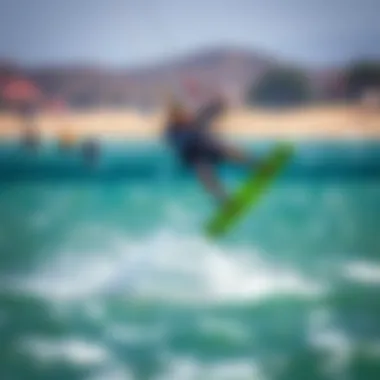
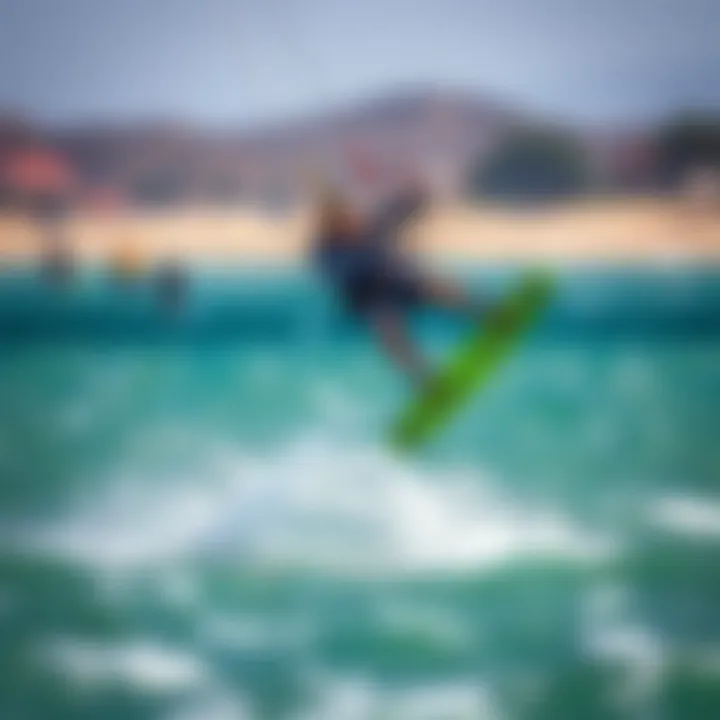
Starting with the basics is paramount for anyone venturing into kiteboarding. Newcomers must first familiarize themselves with their gear, focusing on how to handle the kite effectively. A key characteristic of starting with the basics is its simplicity; it empowers riders to build a strong foundation in kite control and balance. The benefits of mastering these foundational skills cannot be overstated. They prepare a rider's body and mindset for the more complex maneuvers ahead, reducing the risk of accidents and boosting confidence.
One unique feature here is the emphasis on repetition. This approach allows riders to gradually internalize each movement. For instance, practicing how to direct the kite, perform controlled landings, and demonstrate balance on the board allows one to spot personal strengths and weaknesses effectively. However, a disadvantage could be the temptation to rush through these stages; turning a blind eye to the basics may lead to complications later on.
Progressing Gradually
After acquiring the fundamental skills, progressing gradually becomes the next logical step. This phase involves integrating new elements while refining those already learned. A key characteristic of progressing gradually is its focus on incremental challenges, enabling riders to take on newfound skills with assurance. The gradual transition from practicing basic movements to slightly more challenging ones—like sharp turns—ensures a sustainable learning curve.
The unique feature of this stage includes keeping an eye on personal limits, which varies among riders, giving them space to advance without pushing too hard too quickly. This is beneficial as the rider maintains a balance in learning and enjoyment. However, there’s also a potential downside: if one becomes fixated on rapid improvement, frustrations may arise from an intense desire to master future techniques which can hinder overall progress.
Advanced Techniques
Executing Precision Turns
Executing precision turns in strike ride marks a significant leap for every rider. This advanced technique is a culmination of everything learned thus far, merging skills in kite control with board maneuverability. The key characteristic of precision turns lies in the rider’s ability to redirect both the kite and body simultaneously in a harmonious flow, which is essential for maintaining speed and control while navigating more challenging waters or competing.
The advantage is clear: a solid execution can serve not only functional aspects but also enhance the aesthetic aspect of riding. However, mastering this skill may prove difficult for some, as it requires a deep understanding of personal timing and coordination. Care must be taken to avoid the pitfall of over-driving these turns, which can catch a rider off guard during high-speed maneuvers.
Jumping and Tricks
Jumping and tricks are the cherries on top of mastering strike ride. They represent a combination of artistry and technicality. This aspect helps riders express themselves while utilizing newly honed skills. The key characteristic of jumping lies in its ability to defy gravity and showcase personal style, allowing for a multitude of maneuvers such as rotations or flips that can make one stand out in the sea of kiteboarders.
The unique feature here is the requirement for dynamic body movements; timing is everything. Riders must synchronize the kite's lift and their take-off on the board. The advantages of jumping include the element of thrill it brings, potentially boosting the rider’s overall experience and providing a means of social recognition. However, it’s crucial to note that improper execution can lead to falls or unplanned landings. Mastery in this domain demands consistent practice, coupled with a solid grounding in earlier skills.
Physical Training for Strike Ride
When it comes to mastering strike ride in kiteboarding, physical training plays a crucial role in shaping the skills and endurance required for this thrilling sport. The rigors of navigating varying wind conditions, managing the kite, and performing tricks all necessitate a high level of physical fitness. This section aims to shed light on the key components of physical training specifically tailored for strike ride, emphasizing the vital importance it has in enhancing performance and safety on the water.
Strengthening Core Muscles
Core strength serves as the cornerstone of effective kiteboarding. A strong core stabilizes the body while navigating the unpredictable forces of wind and waves. When you’re perched on your board, a powerful core aids in balance and control, allowing for smoother rides and more precise movements.
- Benefits of Core Strength:
- Improved balance helps in managing the kite’s power.
- Enhanced posture reduces the risk of injury during tricks or falls.
- Increased stability supports a stronger, more confident ride.
To build core strength, consider exercises like planks, Russian twists, and hanging leg raises. These exercises engage various muscle groups, promoting an all-around stronger core. Remember, consistency is key. A few focused sessions each week can make a significant difference.
Endurance and Flexibility Exercises
Endurance and flexibility are equally important when it comes to strike ride. Kiteboarding can be a physically demanding sport that requires prolonged exertion and quick adjustments. Thus, incorporating both endurance and flexibility training into your routine is a smart move.
- Incorporating Endurance Workouts:
- Boosting Flexibility:
- Running or Cycling: Building cardiovascular endurance is about sustaining energy throughout your sessions. Aim for 30-60 minutes of continuous activity at least three times a week.
- Circuit Training: Engaging in high-intensity interval training can enhance muscular endurance and elevate your heart rate simultaneously.
- Yoga or Stretching Routines: Incorporating yoga poses like the downward dog or pigeon pose can vastly improve flexibility, which is crucial for adjusting body positions during maneuvers.
- Dynamic Stretching: Start your training sessions with dynamic stretches to warm up and prepare your muscles for action.
Investing time in your physical training will not only enhance your strike ride experience but will also minimize injuries, making your kiteboarding adventures far more enjoyable.
By focusing on these physical training elements—strengthening the core, improving endurance, and enhancing flexibility—you will pave the way for a more exhilarating and effective kiteboarding experience. The next section will explore how to incorporate these physical training concepts into a practical regimen.
Community and Resources
In the realm of kiteboarding, the importance of community and resources cannot be understated. Connecting with fellow riders and supportive organizations elevates not only one's skills but also enhances the overall experience in this thrilling sport. The sharing of knowledge, tips, and experiences among kiteboarders helps to create a network of individuals who support one another. This section delves into both local clubs and online platforms that serve as key components in empowering enthusiasts to blossom in their craft.
Joining Kiteboarding Communities
Local Clubs and Organizations
Local clubs and organizations are the lifeblood of kiteboarding communities, providing essential support for both novices and seasoned veterans. These groups bring together people who share a common passion, creating a sense of belonging that transforms individuals into friends and mentors. One key characteristic of local clubs is their emphasis on hands-on learning. Instructors often share insights and tips based on their firsthand experiences, so beginners can quickly learn the ropes without trial and error.
A significant advantage of joining these clubs is access to organized events and workshops, where riders can hone their skills and try different styles under the guidance of experienced members. However, it’s worth mentioning that entry fees or membership dues could be a drawback for some individuals, but the return on investment in terms of skill development and community support largely outweighs this hurdle.
Online Platforms and Forum Engagement
Modern technology has paved the way for online platforms and forums to become pivotal in the kiteboarding scene. These virtual spaces serve as gathering spots for discussions, where enthusiasts share advice, anecdotes, and updates about events. A key feature of these online communities is their inclusivity; anyone with a reliable internet connection can participate.
Engaging with these forums can provide an array of perspectives on various topics, from gear recommendations to tips for tackling challenging conditions. However, one must exercise caution when following unverified advice, as not all suggestions are backed by experience. Still, the potential for diverse insights makes online platforms a treasure trove for those looking to deepen their understanding of strike ride and kiteboarding in general.
Resources for Continued Learning
Continual learning is integral to skill enhancement in kiteboarding. Acknowledging this, various resources are available that cater to different learning styles and preferences. Recommended reading and instructional videos are notable elements in this pursuit of knowledge.
Recommended Reading
Books and articles dedicated to kiteboarding techniques, equipment, and safety practices provide a solid foundation for riders at all levels. A key characteristic of recommended reading is the depth of knowledge embedded within these texts, often crafted by seasoned professionals. These publications offer insights that can only come from years of experience on the water.
Engaging with this material helps kiteboarders understand theoretical concepts behind techniques like strike ride, which informs their practical application in real-world scenarios. The downside may be the time investment required to read and digest such material, but the comprehensive knowledge gained is undoubtedly worth it.
Instructional Videos and Guides
For those who prefer visual learning, instructional videos and guides are a boon for aspiring kiteboarders. These resources enable riders to see techniques in action, which can often clarify concepts that might be difficult to grasp through text alone. Videos allow learners to visualize the nuances in kite control, board positioning, and body mechanics involved in strike riding.
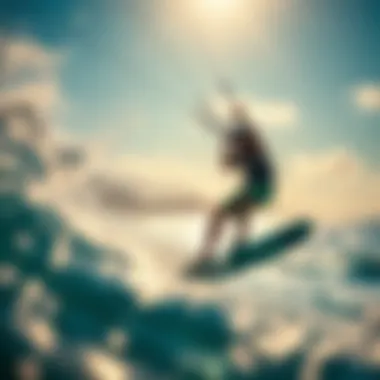
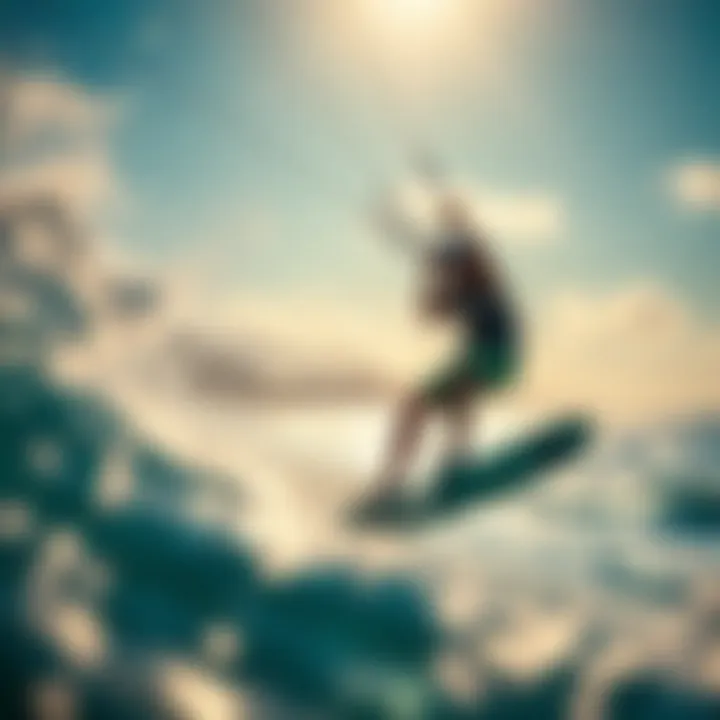
One unique feature of video resources is the variety of presenters and styles available — some may resonate more with particular learners than others. While it's easy to become overwhelmed with the sheer volume of content available, curating a handful of reputable channels or creators can streamline the learning process. By following well-regarded sources, riders can immerse themselves in valuable content without drifting into the realm of misinformation.
The journey of mastering strike ride is paved with community support and informed learning. Connect with like-minded people and explore diverse resources to elevate your kiteboarding experience.
Impact of Weather on Strike Ride
Understanding the dynamics of weather is crucial for every kiteboarder, especially for those who engage in strike riding. Not only does the weather influence the performance of kites, but it also affects safety and overall riding experience. From wind speed to temperature fluctuations, each weather element plays a significant role in how well a rider maneuvers the kite and board.
The ability to read and adapt to weather conditions is one of the defining traits of an experienced rider. When you are out on the water, knowing when to ride or when to call it a day can make the difference between an exhilarating experience and a potentially dangerous situation. Training yourself to anticipate weather changes will boost your confidence and improve your skills in strike riding.
Understanding Wind Patterns
Wind patterns form the backbone of successful kiteboarding. Familiarizing yourself with the behavior of winds in your preferred spots can greatly enhance your strike ride. For instance, knowing whether you are dealing with thermal winds, sea breezes, or mountain winds can inform how you manage your kite.
Each wind type comes with its nuances:
- Thermal winds typically occur during warm days and can pick up significantly as the sun rises. Riders can expect stronger, steadier winds in the afternoon.
- Sea breezes develop when land heats up quicker than the water, resulting in a consistent wind coming in from the sea. These winds can make riding a delight but can also change abruptly, causing the inexperienced rider to be caught off guard.
- Mountain winds can be a bit tricky. They may include turbulent gusts due to thermal influences and should be monitored closely, as they can shift unexpectedly with weather fronts.
Recognizing these patterns and adapting to them can allow you to make the most out of your riding sessions.
Managing Changing Conditions
Weather can be a fickle mistress, and conditions can shift faster than you can blink. That means every kiteboarder must be prepared. The first step in managing sudden changes in conditions is to always keep an eye on the sky and water.
- Check Weather Forecasts: Before heading out, make it a habit to consult various weather sources. Websites like NOAA (National Oceanic and Atmospheric Administration) or local news stations provide insights on wind forecasts and potential weather changes.
- Watch Other Riders: If you’re at a popular kiteboarding destination, keep an eye on experienced riders. Their body language and technique often change with the wind conditions, offering you real-time insights on the situation.
- Practice Responsive Riding: Maintain a flexible riding technique. If you notice the wind picking up or becoming sporadic, be ready to adapt your kite control. This might mean flattening out your kite for more depower when winds get too strong or adjusting the angle of your board to place yourself in a better position.
"Good riders are those who can read the wind as easily as they read the water."
In the realm of strike ride, the interplay between kite and rider becomes even more vital under changing conditions. Embrace the unpredictability of weather by being prepared, informed, and adaptable. This proactive approach not only enhances your enjoyment but ensures that your passion for kiteboarding remains safe and sustainable.
Key resources for further knowledge include:
- Kiteboarding.com
- National Weather Service
- Kitesurfing Forum on Reddit
- Kiteboarding Safety Guidelines by the International Kiteboarding Association
By understanding weather patterns and managing changes effectively, kiteboarders can elevate their strike riding skills while ensuring the thrill of the ride is matched only by the safety of their experience.
Exploring Global Strike Ride Destinations
When it comes to kiteboarding, the thrill of the ride is inextricably linked to the chosen location. Exploring global strike ride destinations is not just about finding the best wind and waves; it’s also about immersing oneself in local cultures and traditions that can elevate the experience. Each destination boasts unique elements that cater to kiteboarding enthusiasts and presents various considerations that can shape a rider’s experience.
Top Locations for Kiteboarding
The world is dotted with prime kiteboarding spots, each offering something special. Here are a few top locations:
- Tarifa, Spain: Known for its consistent winds and stunning Mediterranean backdrop, Tarifa is a hotspot for both beginners and experienced riders.
- Maui, Hawaii: With its powerful trade winds and diverse wave conditions, Maui is a mecca for kiteboarders looking to tackle various tricks and techniques.
- Cape Town, South Africa: Offering breathtaking natural beauty and diverse water conditions, Cape Town's beaches attract kiteboarding enthusiasts all year round.
- Cumbuco, Brazil: Famous for its flat waters and steady wind conditions, Cumbuco promises a friendly vibe that caters to kiteboarders of all skill levels.
These locations not only promise exciting rides but also a chance to connect with like-minded individuals and engaging local communities.
Understanding Local Cultures and Conditions
Interacting with Locals
Engaging with local communities can transform a kiteboarding trip from a simple adventure into a cultural experience. Interacting with locals facilitates the exchange of knowledge about site-specific conditions, local tricks, and safety tips. This not only enhances safety but also helps riders understand the nuanced differences in riding styles and techniques prevalent in each region.
- Cultural Exchange: Locals often know hidden gems, secluded spots, or time-framed conditions that are not widely publicized. Building rapport can lead to insider information that can enhance a kiteboarder's experience.
- Safety Net: Relying on local knowledge may help in identifying hazards that one may overlook. Understanding regional practices ensures that riders are kept safe and informed.
While interacting with locals can be rewarding, a rider should approach it with humility and respect to maximize the experience without imposing.
Observing Regional Practices
Observing regional practices is another crucial aspect to grasp while kiteboarding in different locations. Each area has its unique set of rules and etiquette that can largely affect one’s performance and interactions while out in the waters.
- Learning from the Local Scene: Paying attention to how locals position themselves on the water gives insights into riding strategies from the pros of that region. This may include local techniques for at tackling tricky spots or utilizing wind fluctuations effectively.
- Respect for Customs: Every kiteboarding destination comes with its cultural norms, some of which are intricately tied to local practices. Respecting these traditions can open doors to richer interactions and foster goodwill.
Navigating through the different regional practices can feel daunting, yet, the value found in understanding and adapting to local ways can significantly enrich the overall sail experience.
"Being open to learning from local kiteboarders not only improves riding skills but also builds lasting friendships around the globe."
As you plan your kiteboarding adventures, keep these aspects in mind. Be it Tarifa’s vibrant surf culture or Maui’s laid-back vibe, each destination offers out something that can amplify your kiteboarding experience, making memories that last a lifetime.
The Future of Strike Ride
The concept of strike ride in kiteboarding is on the cusp of significant evolution. As kiteboarding continues to gain traction globally, the future of this exhilarating technique promises to be influenced by advancements in technology, shifts in kiteboarding culture, and environmental considerations. Taking a closer look at these aspects is not only fascinating but crucial for those immersed in the world of kiteboarding.
Innovations in Gear and Technology
The continual advancements in gear technology are perhaps the most exciting aspect of the future of strike ride. Kite manufacturers are consistently pushing the envelope to provide equipment that enhances performance, safety, and user experience. Customization of kites and boards is becoming more prevalent, allowing riders to fine-tune their gear to meet individual preferences or riding styles.
- Lightweight Materials: Emerging materials reduce the overall weight of kites without compromising durability. This allows for better maneuverability during striking, providing riders an edge in terms of speed and responsiveness.
- Smart Technology: The introduction of embedded sensors within kites can monitor wind conditions and suggest adjustments in real time, creating a more adaptive ride experience. These innovations not only enhance performance but also improve safety by providing data on conditions that could lead to dangerous situations.
- Eco-Friendly Options: The kiteboarding industry is slowly moving towards sustainability. Brands are now offering eco-conscious alternatives that utilize recycled materials, addressing environmental concerns while maintaining quality standards. Riders may find more choices that not only excel in performance but also reflect a commitment to the planet.
Emerging Trends in the Sport
As the sport of kiteboarding evolves, several trends are emerging that reflect changing rider needs and preferences.
- Community-Driven Learning: Increased collaboration within local kiteboarding communities fosters collective growth. New riders can benefit from shared experiences and peer reviews of techniques. This trend strengthens connections and expands knowledge across the sport.
- Adaptation to Environmental Changes: As climate change affects wind patterns and water conditions, there is a growing need for riders to adapt their strategies. Awareness of local environments and staying attuned to weather forecasts has become crucial. Kiteboarders who can adjust swiftly to these variables are better positioned to thrive.
- Diversity in Riding Styles: The scene is seeing a blend of traditional and contemporary riding styles. With influences from other action sports, riders are integrating techniques and maneuvers that were once considered outside the realm of kiteboarding, creating a vibrant tapestry of riding approaches.
"The future is brighter for those who embrace change and innovation in kiteboarding. It’s not just about how you ride; it’s about how you adapt and thrive in a rapidly changing environment."
Embracing these innovations and trends will not only enhance individual experiences but can also play a significant role in shaping the kiteboarding scene for future generations. For riders, understanding these dynamics is vital in remaining relevant, competent, and safe in their pursuit of the sport.
Specifically, recommendations to further explore this growing hobby can be found on various reputable sources such as Wikipedia, Britannica, and discussions on Reddit. These platforms can provide additional insights and community feedback for those seeking to expand their horizons in kiteboarding.



